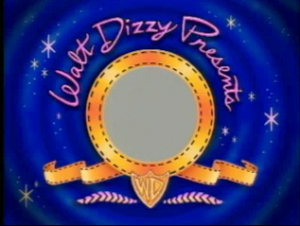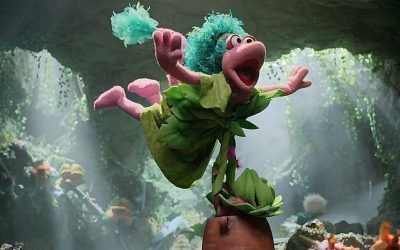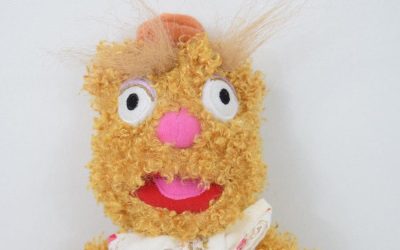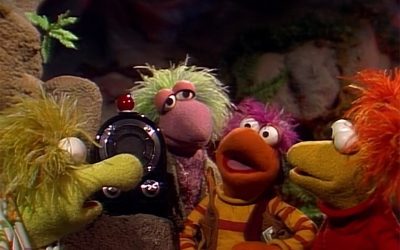Part 1: How Norman Got to Sesame Street
Part 2: Mel Brooks, The Count, and Bert & Ernie
Part 3: Mr. Hooper, Sesame songwriting, and BTPNN
 Norman wrote for Sesame Street full-time for the next few years, serving as head writer for about a year in 1973. In 1974, Norman’s colleague and Electric Company writer John Boni decided to go out to Los Angeles to try and sell a TV show pilot they wrote together. The show was a Robin Hood parody, then titled “Waiting for Richard”. They managed to get their script into the hands of Norman Steinberg, who wrote the screenplay for another recent period comedy: Blazing Saddles. Steinberg delivered the script to Mel Brooks, who agreed to help write and co-create the project, which convinced Paramount to pick up the series, which they retitled “When Things Were Rotten”. The series lasted only 13 episodes. Despite critical acclaim, the show was very expensive to produce. Paramount built a large forest set, as well as a castle for the show, but the ratings weren’t big enough to justify the expense. When Things Were Rotten was eventually replaced by Laverne and Shirley, and we all know how that went.
Norman wrote for Sesame Street full-time for the next few years, serving as head writer for about a year in 1973. In 1974, Norman’s colleague and Electric Company writer John Boni decided to go out to Los Angeles to try and sell a TV show pilot they wrote together. The show was a Robin Hood parody, then titled “Waiting for Richard”. They managed to get their script into the hands of Norman Steinberg, who wrote the screenplay for another recent period comedy: Blazing Saddles. Steinberg delivered the script to Mel Brooks, who agreed to help write and co-create the project, which convinced Paramount to pick up the series, which they retitled “When Things Were Rotten”. The series lasted only 13 episodes. Despite critical acclaim, the show was very expensive to produce. Paramount built a large forest set, as well as a castle for the show, but the ratings weren’t big enough to justify the expense. When Things Were Rotten was eventually replaced by Laverne and Shirley, and we all know how that went.
Still, Norman did get to work with Mel Brooks, which is amazing. We asked what it was like working with him, and Norman told us this story: While they were working on their series, Brooks invited the crew to a private screening of his next film, Young Frankenstein, and Brooks was characteristically late. While they waited, Norman noticed that he was sitting near the legendary TV writer and producer Norman Lear. Soon after, they hear a voice boom from the back of the theater (which Norman imitated with great accuracy), “NORMAN STILES AND NORMAN LEAR! YOU ARE SITTING NEXT TO EACH OTHER.” Observational humor at its best.
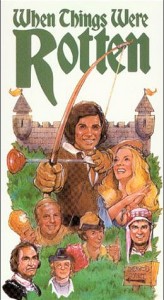 According to Norman, if you’re a writer in Hollywood and someone asks you what you’re working on, if you say “I’m working on a script…”, that’s great news. If you say, “I just finished a script…”, that means you are out of work. After When Things Were Rotten, Norman kept himself in the former category as much as possible, writing for America 2-Night and Fernwood 2 Night, as well as the extremely short-lived Captain and Tenille Show. Another such production he contributed to was a four-episode summer series starring Frankie Avalon called “Easy Does It”. The sketch he remembers most fondly is “The Transwolfite Story” (for which he’s quick to credit John Boni for the idea), which was about people who like to dress up like wolves, including special guest star Andy Griffith. In one scene, a gas station owner is interviewed while a “transwolfite” pumps gas in the background. He says, “I really have no problem with it. They’re just good workers!” The sketch ends with the non-sequitor, “Next week, our subject will be mayonnaise – the deodorant of the future!”
According to Norman, if you’re a writer in Hollywood and someone asks you what you’re working on, if you say “I’m working on a script…”, that’s great news. If you say, “I just finished a script…”, that means you are out of work. After When Things Were Rotten, Norman kept himself in the former category as much as possible, writing for America 2-Night and Fernwood 2 Night, as well as the extremely short-lived Captain and Tenille Show. Another such production he contributed to was a four-episode summer series starring Frankie Avalon called “Easy Does It”. The sketch he remembers most fondly is “The Transwolfite Story” (for which he’s quick to credit John Boni for the idea), which was about people who like to dress up like wolves, including special guest star Andy Griffith. In one scene, a gas station owner is interviewed while a “transwolfite” pumps gas in the background. He says, “I really have no problem with it. They’re just good workers!” The sketch ends with the non-sequitor, “Next week, our subject will be mayonnaise – the deodorant of the future!”
One of his favorite things he ever wrote with John Boni was on America 2-Night. During a full week of new episodes, the show announced that they want to give the American people what they want. And what they like is clearly the death penalty, so they’re going to execute somebody right on their stage. After five nights of teasing the big event, the show’s hosts learn that they aren’t allowed to execute anyone on their stage, so they rig a cartoonishly large electrical switch directly connected to the prison. At the last minute, someone stops the insanity and pleads, “I think we should all take a minute and think about this.” The cast goes silent for a full minute (which is an eternity on television), and then gleefully announce, “On with the show!”
Eventually he found himself calling the writing staff at Sesame Street to see if he could come back part-time so he could guarantee a steadier paycheck. To say that they were enthusiastic is an understatement. Norman worked bi-coastally for the next few years, delivering scripts over the phone when necessary. Over time, his New York presence grew and grew until he was back at Sesame Street full-time again.
Norman still gets royalty checks from his time writing in Hollywood. They’re usually about 10¢ each. One time, he took a whole stack of checks to the bank, which totaled about 90¢. And who says show business doesn’t pay?
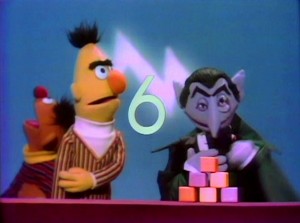 One of Norman’s greatest and longest-lasting accomplishments, in my opinion, is that he is responsible for creating The Count. He found the idea of a Count who counts to be very funny, and soon after wrote the joke (which never appeared on Sesame Street) “I vant to count your neck! One! One neck!” He delivered his first script to Jeff Moss, who responded with, “Great character, bad bit.” He imagined the Bela Lugosi voice and the trademark laugh, but he couldn’t take credit for the thunder and lightning (which is an addition he loved). Norman envisioned Jerry Nelson as The Count’s performer, and Jeff Moss told him that if he wanted Jerry, he’d have to ask him himself. So Norman, who was still new to the writing staff, shyly asked Jerry if he would be interested in performing this new character. And then he had to ask again, because Jerry asked him to speak up. And thus, a children’s television icon was born.
One of Norman’s greatest and longest-lasting accomplishments, in my opinion, is that he is responsible for creating The Count. He found the idea of a Count who counts to be very funny, and soon after wrote the joke (which never appeared on Sesame Street) “I vant to count your neck! One! One neck!” He delivered his first script to Jeff Moss, who responded with, “Great character, bad bit.” He imagined the Bela Lugosi voice and the trademark laugh, but he couldn’t take credit for the thunder and lightning (which is an addition he loved). Norman envisioned Jerry Nelson as The Count’s performer, and Jeff Moss told him that if he wanted Jerry, he’d have to ask him himself. So Norman, who was still new to the writing staff, shyly asked Jerry if he would be interested in performing this new character. And then he had to ask again, because Jerry asked him to speak up. And thus, a children’s television icon was born.
Norman is also quick to credit Sharon Lerner, who served as the head of Research at the time, for a lot of what made The Count (and Sesame Street as a whole) so successful. Lerner set the tone for the respectful collaboration between the researchers and the writers to help make every element of the show as educational, as funny, and as high in quality as we now know it to be. “We couldn’t possibly have written anything that delivered the correct curriculum without Sharon’s input,” said Norman, “which usually came with a large dose of laughing, appreciation and quite often nuggets that made segments funnier.” Norman is proud to spread the word about Lerner’s involvement and to make sure she gets her long overdue credit for the mark she left on the series.
Norman tells us that he doesn’t write any differently for children versus adults. In the end, it just needs to be real. He also didn’t have a favorite or most challenging character to write for. Many writers claimed to have trouble with Big Bird, but Norman said that Big Bird was really useful when they needed someone to ask the questions a child would ask, and he was more versatile than other characters because he could get upset or angry in a realistic way, just like a child.
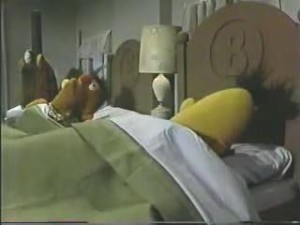 So which comes first: The comedy or the curriculum? Norman found that the educational lesson was what prompted almost all of his writing. Without it, there’s no inspiration for coming up with a good bit. He likened it to advertising, where you can’t write an ad pitch without knowing what the product is first (an appropriate analogy, since advertising was part of the fabric of the show’s initial development). However, he did reveal that some sketches were repurposed from old comedy routines. For example, in one sketch, Bert and Ernie are in bed and Ernie wants a glass of water. “Boy am I thirsty! Am I thiiiirsty!” Bert, thoroughly annoyed, gets up to get Ernie some water. Not satisfied, Ernie starts again with, “Boy am I THIRSTY!”, so Bert gets out of bed again to get his friend another glass of water. Ernie is still parched, and exclaimed, “Am I thiiiiirsty!” yet again. Bert tells him he’ll get him another glass of water, as long as he doesn’t say he’s thirsty again. Ernie promises, drinks his water and lays his head back down on his pillow. “Boy, was I thirsty…”
So which comes first: The comedy or the curriculum? Norman found that the educational lesson was what prompted almost all of his writing. Without it, there’s no inspiration for coming up with a good bit. He likened it to advertising, where you can’t write an ad pitch without knowing what the product is first (an appropriate analogy, since advertising was part of the fabric of the show’s initial development). However, he did reveal that some sketches were repurposed from old comedy routines. For example, in one sketch, Bert and Ernie are in bed and Ernie wants a glass of water. “Boy am I thirsty! Am I thiiiirsty!” Bert, thoroughly annoyed, gets up to get Ernie some water. Not satisfied, Ernie starts again with, “Boy am I THIRSTY!”, so Bert gets out of bed again to get his friend another glass of water. Ernie is still parched, and exclaimed, “Am I thiiiiirsty!” yet again. Bert tells him he’ll get him another glass of water, as long as he doesn’t say he’s thirsty again. Ernie promises, drinks his water and lays his head back down on his pillow. “Boy, was I thirsty…”
One of Norman’s favorite sketches that he’d written was the classic Bert and Ernie sketch where Ernie broke the cookie jar, so, through a series of replacements, Bert has to wear a pot on his head. Despite its popularity, Norman said that if he knew then what he knows today about writing for kids, he wouldn’t have ended it with Ernie dropping the pot on Bert’s head and saying “Ride ‘em, cowboy!” Instead, he’d add a few extra lines of dialog. Bert would say, “Who would want to play with a cowboy wearing a pot on his head?” And then Ernie would put a pot on his own head and say, “Come on! You want to be the bad guy?” Norman wouldn’t want to end a sketch with one character “losing” against the other. Instead, he’d want to show why these two were friends to begin with.
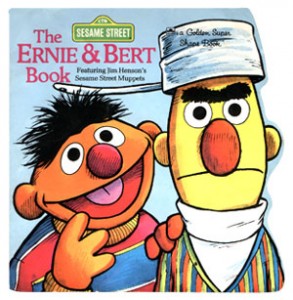 Speaking of Bert and Ernie, Norman said that he always felt intimidated when writing for Jim Henson and Frank Oz. He would be nervous during filming in a way he didn’t feel with the other performers. He had the constant feeling at any moment that Jim and Frank would tell him that his script was terrible. The strange thing is, they never reacted that way. They were always friendly and professional, and Norman welcomed their ad-libs, which always made the sketches funnier.
Speaking of Bert and Ernie, Norman said that he always felt intimidated when writing for Jim Henson and Frank Oz. He would be nervous during filming in a way he didn’t feel with the other performers. He had the constant feeling at any moment that Jim and Frank would tell him that his script was terrible. The strange thing is, they never reacted that way. They were always friendly and professional, and Norman welcomed their ad-libs, which always made the sketches funnier.
Norman has an immense respect for all of the Muppet performers. He said that everyone he ever worked with is incredibly nice and not at all egotistical. His theory as to why is because all of their work is done from the arm up. Their faces don’t appear on camera, so they’re not the stars; the characters are. It’s much more about the art than fame.
In writing for puppets, there are certain challenges. For example, when shooting the special “Free to Be a Family” in Moscow, Norman had the idea to have Kermit push a document across a table to his Russian counterpart, Khriusha the Pig. “And how are we supposed to do that?” Jim Henson asked. Realizing the limitations of the characters, Norman responded with, “You’ll think of something!” Another thing to look out for was negative modeling. For example, you can’t write a scene in which Big Bird tries to learn how to fly by climbing up on the roof and jumping off. They always had researchers on set to make sure lessons were clear and realistic.
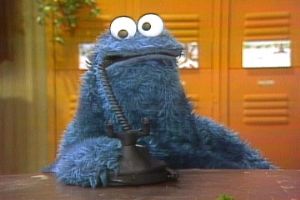 However, Norman doesn’t think Cookie Monster displays negative modeling, as some parents have claimed. He says that kids are smart enough to realize that Cookie Monster is an exaggerated character who behaves erratically. It’s why he’s a Cookie Monster and not a Cookie Kid. If he was tasked with writing Cookie Monster as a healthier eater, he might not have had him give up his favorite treats. (“What, was he brainwashed? Was he tied to a chair in a room pumped with loud music?”) Instead, he suggested creating a character called The No-Cookie Monster, who is identical to Cookie Monster but hates cookies. Ingenious.
However, Norman doesn’t think Cookie Monster displays negative modeling, as some parents have claimed. He says that kids are smart enough to realize that Cookie Monster is an exaggerated character who behaves erratically. It’s why he’s a Cookie Monster and not a Cookie Kid. If he was tasked with writing Cookie Monster as a healthier eater, he might not have had him give up his favorite treats. (“What, was he brainwashed? Was he tied to a chair in a room pumped with loud music?”) Instead, he suggested creating a character called The No-Cookie Monster, who is identical to Cookie Monster but hates cookies. Ingenious.
Speaking of the educational message getting in the way of the writing, he told a story about an episode he wrote in which “Walt Dizzy” comes to Sesame Street to find someone to cast as the chicken in his new movie about animals. Elmo decides, for some reason, that Telly would be perfect for the role. But Telly doesn’t know the first thing about chickens! Through the episode, Elmo teaches Telly all about the farm animal, from the feathers to the eggs, to the reason they cross the road. In the end, Dizzy gives the role to Elmo, since he’s obviously the chicken expert. But nobody “loses” on Sesame Street; Telly gets cast as the chicken farmer.
The researchers came to Norman with an issue with the Walt Dizzy script. They asked, “Why didn’t a chicken get the part?” It sounded like they missed the point of the story. But as they explained, the story mimicked that of Native Americans and Asians who were passed over for acting roles in favor of Caucasians in makeup. Norman’s answer: No chickens auditioned. The episode aired as written.
Once again, we hope you’ll check out the Indiegogo campaign for Norman’s upcoming project: BTPNN, featuring more puppets, more babies, and more CNN spoofs than you can shake a rattle at! And then stay tuned for part 3 of our interview, coming shortly!
Click here to put a pot on your head on the ToughPigs forum!
by Joe Hennes – Joe@ToughPigs.com

